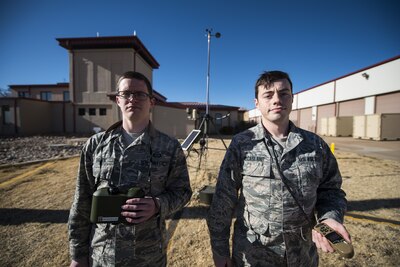By Air Force Senior Airman Lane T. Plummer 27th Special
Operations Wing
When Air Force pilots based here prepare for flight, they
need the help of 27th Special Operations Support Squadron weather forecasters
to contribute to their safety and mission success.
Air Force Staff Sgt. Joseph Klein, 27th SOSS weather
forecaster, is one of those airmen who unlock the weather-related puzzle.
“We provide forecasts for the local area, as well as [other
parts of] New Mexico, Colorado, Arizona and Texas,” Klein said. “We also do
resource protection. That way, if any bad weather is inbound on our location,
we can alert units around base to ensure equipment doesn’t get damaged.”
Weather forecasters here work alongside pilots, using the
latest technology to predict weather patterns, prepare forecasts and
communicate weather information to pilots so every mission can be carried out.
Teamwork
“It helps that we work so close with aircraft crews,” Klein
said. “[In my previous bases], we didn’t get too much face time with them. Here
at Cannon, we’re interacting with each other much more, and that’s convenient
for the pilots. We can provide verbal briefings quickly for the aircrews.”
This constant communication is necessary in an environment
as unique as eastern New Mexico, where dangerous weather conditions can pop up
quickly, Klein said.
“[Wildfire] weather is a particular danger in the local
area,” he explained. “We have to remain cautious and vigilant on live-fire
exercises at Melrose Air Force Range due to how dry the weather can be.”
Quickly moving wildfires are a danger throughout the state.
According to the New Mexico Energy Minerals and Natural Resources Department,
about 118,000 acres were burned by wildfires in 2016, higher than the national
average of 108,000 that year.
Tricky Weather Patterns
A cause for this can also be explained by a collision of
weather fronts that presents a challenge to all weather forecasters across the
state, especially Cannon’s, Klein said.
“We’re on what we call a dry line,” he explained. “It’s a
unique feature to this part of the world. We get the front from the Gulf Coast
pushing moisture west and the southwest front pushing dry air east, and where
the two constantly collide is within the vicinity of Cannon. It’s a danger to
our pilots. We need to always be on the lookout for around late spring and
early summer.”
This combination of a high-pace mission and high-risk
weather presents a challenge to weather forecasters like Klein, but it doesn’t
come without its enjoyable aspects, he said.
“The job is something different for me,” he said. “Everyone
thinks weather is entirely unpredictable, but we know how to find those subtle
clues in forecasting. I like the challenge of that. It’s sort of a puzzle to
me.”









No comments:
Post a Comment